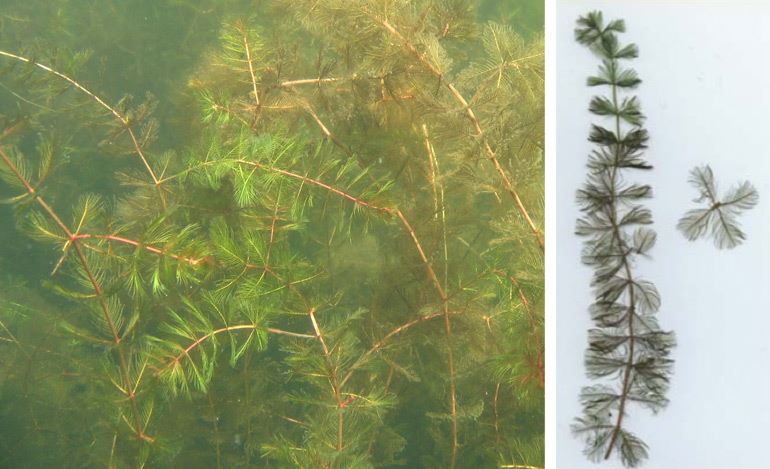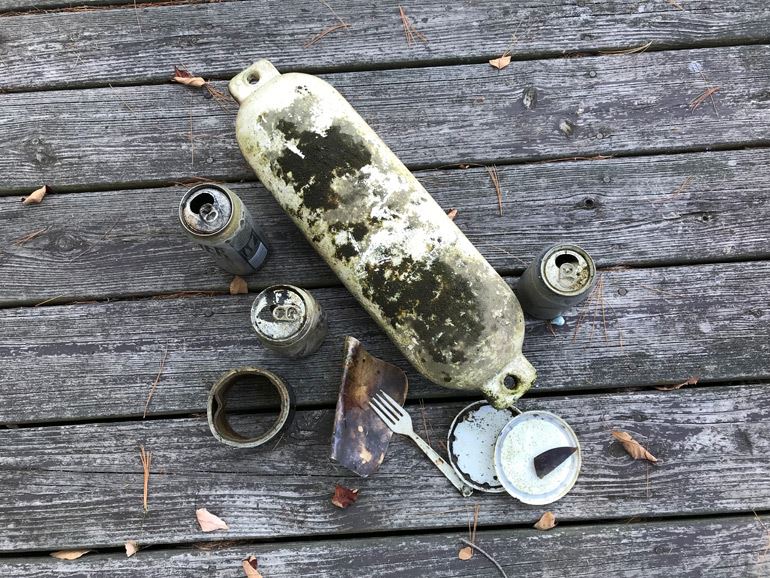Hello Lake St. Catherine. Today, we'd like to give you an end of season report on our 2018 suction harvesting program.
Each year, the LSCA works with 2 contractors to battle the milfoil in the lake, keeping it under control. In mid June, SOLitude Lake Management applied the herbicide Renovate to 5 locations around the lake. Then, throughout the summer, our other contractor Beck Sinclair performed suction harvesting (referred to as DASH - Diver Assisted Suction Harvesting) in other problem areas. Suction harvesting involves a diver hand-pulling the milfoil by the root from the lake bottom. The milfoil is then suctioned through a tube, up to the surface.
You may have seen Beck working on the lake in the LSCA suction harvesting boat:

Last Saturday, Beck provided his end of year report to the board - and we'd like to share that information with you.
This season, 766 containers (20 gallon buckets) were filled with suction harvested milfoil. This is a little more than half of what was removed last season. Beck reported that the amount of milfoil he viewed and worked on was the lowest he'd seen in his 5 years of working on the suction harvesting program. He also observed that milfoil was not as dense or tall. That, along with a reduction in total hours worked, contributed to the difference in the bucket count from last year.
Beck also reported that he was very happy to speak with folks as they would swim, paddle or boat by, thanking him for his work. He suggested that the LSCA should take some time to make sure that we are educating everyone about what milfoil looks like - and how it's different from other native plant species. Milfoil looks like this:

This is the weed that we can suction harvest and target with the spot herbicide treatments.
It is VERY IMPORTANT to remove them by the roots and to make sure no fragments are created. In the illustration image above, even that small piece of milfoil on the right side can float away, sink, and create a new plant - potentially leading to the creation of a whole new bed of milfoil.
The LSC 'old-timers' will remember the way the lake looked back before 2004... Beds of milfoil near the shorelines had created thick mats of weeds on the surface. The LSCA is working very hard to keep it under control each season utilizing this balanced combination of spot herbicide treatments and suction harvesting. We simply cannot let the milfoil get back to the levels we saw before the milfoil control program began in 2004 with the first herbicide treatment.
With this in mind, we'd like to make sure you are aware of some of the ways you can help out:
• First and foremost, your financial support in the form of the yearly dues you contribute to the LSCA are crucial to help fund this program. If you are not currently a member, please consider joining! You can do so easily via our website here: Become A Member, or you can click here to: Make A Donation.
• Near your shoreline, you are permitted to hand-pull any weeds (including weeds other than milfoil) to clean up your area. Swim down to pull them up by the root, or use a rake to assist pulling them up from the bottom. Be sure to remove the weeds you pull from the lake and bring them on shore to dry out. You can then dispose of them as you would with brush from your yard.
• If you see patches of floating milfoil, grab them - and get them out of the lake. As mentioned above, these floating fragments will eventually sink - and they have the potential to seed new beds of milfoil. So, if you can, get as much milfoil out of the lake as possible.
Finally, we'd like to tell about the amount of garbage that Beck collects from the bottom of the lake as he is suction harvesting the milfoil. Take a look at this very small sample:

Bottles, cans, plastic cups - all kinds of garbage. Beck reports that each season, he removes 2 extremely large bags of garbage from the lake bottom.
Does this make you angry? We hope it does - it sure makes us angry.
Here's a photo I took of the garbage I picked up after a recent paddleboard ride along the shoreline near my camp:

We're showing you this to make you aware of the amount of junk that ends up in the lake. We ask that you:
- take a look on your shoreline and in your immediate water area to see if there is any junk you can pick up and remove.
- be careful when your are out on the lake to make sure things like bottles, cans and cups don't fall into the lake.
- keep an eye out for people throwing junk into the lake - call them out and let them know that it's not acceptable.
We all need to do our part to make sure we keep this beautiful lake clean.
At the end of each July, the State of Vermont promotes Clean Water Week as a celebration of Vermont’s 800 lakes and ponds, 23,000 miles of rivers and streams, and 300,000 acres of wetlands. Next year, the LSCA will look to coordinate and sponsor a shoreline cleanup on Lake St. Catherine. We hope you'll volunteer and join us!
We'd like to thank Beck for his efforts this season in helping to keep the milfoil under control - and for cleaning up the garbage he found along the way. Thanks Beck - we all appreciate it!
If you have any questions about the LSCA's milfoil control program, please get in touch at info@lakestcatherine.org.
Are you a member yet? Maintaining the lake costs approximately $125,000 annually. Grants, membership dues and contributions make up the majority of our funding. If you'd like to help, please consider
becoming a member or
making a donation. The LSCA is a 501 (c)(3) non-profit organization and any contribution that you make is tax deductible.